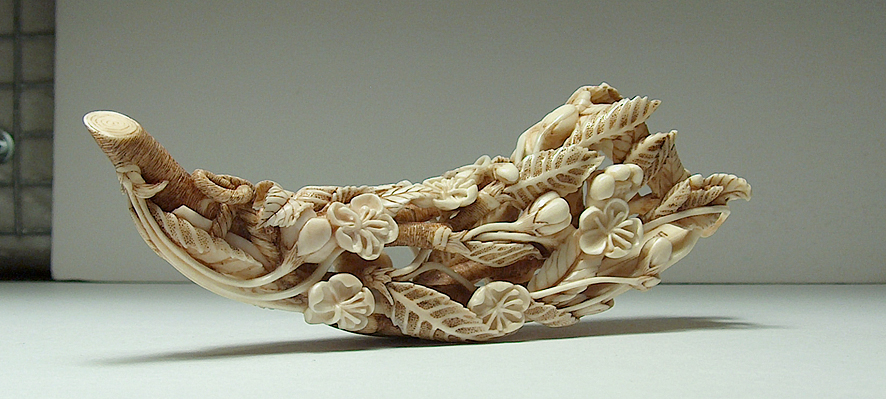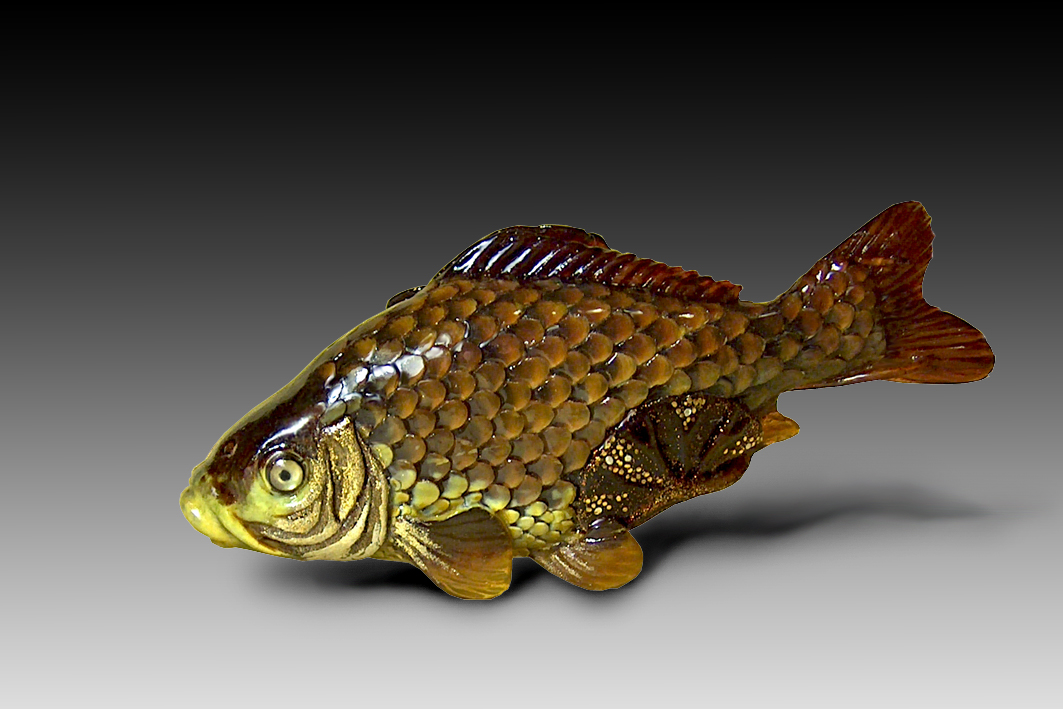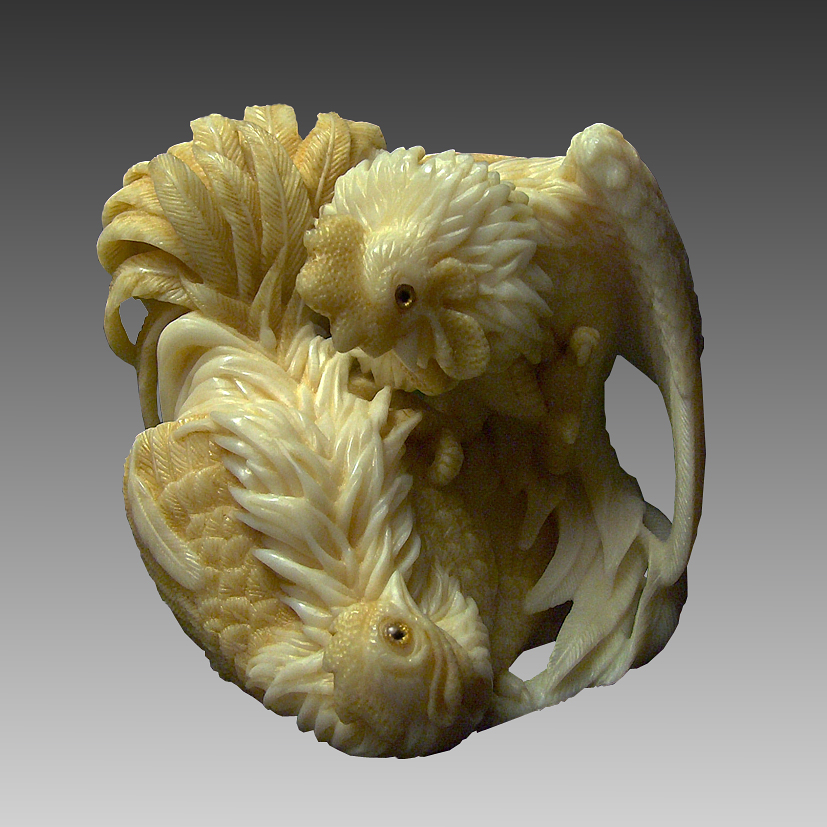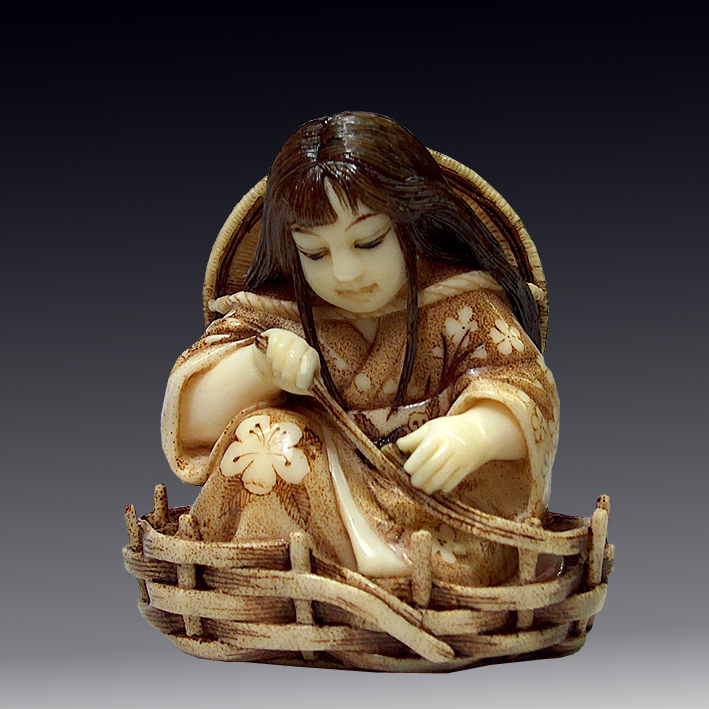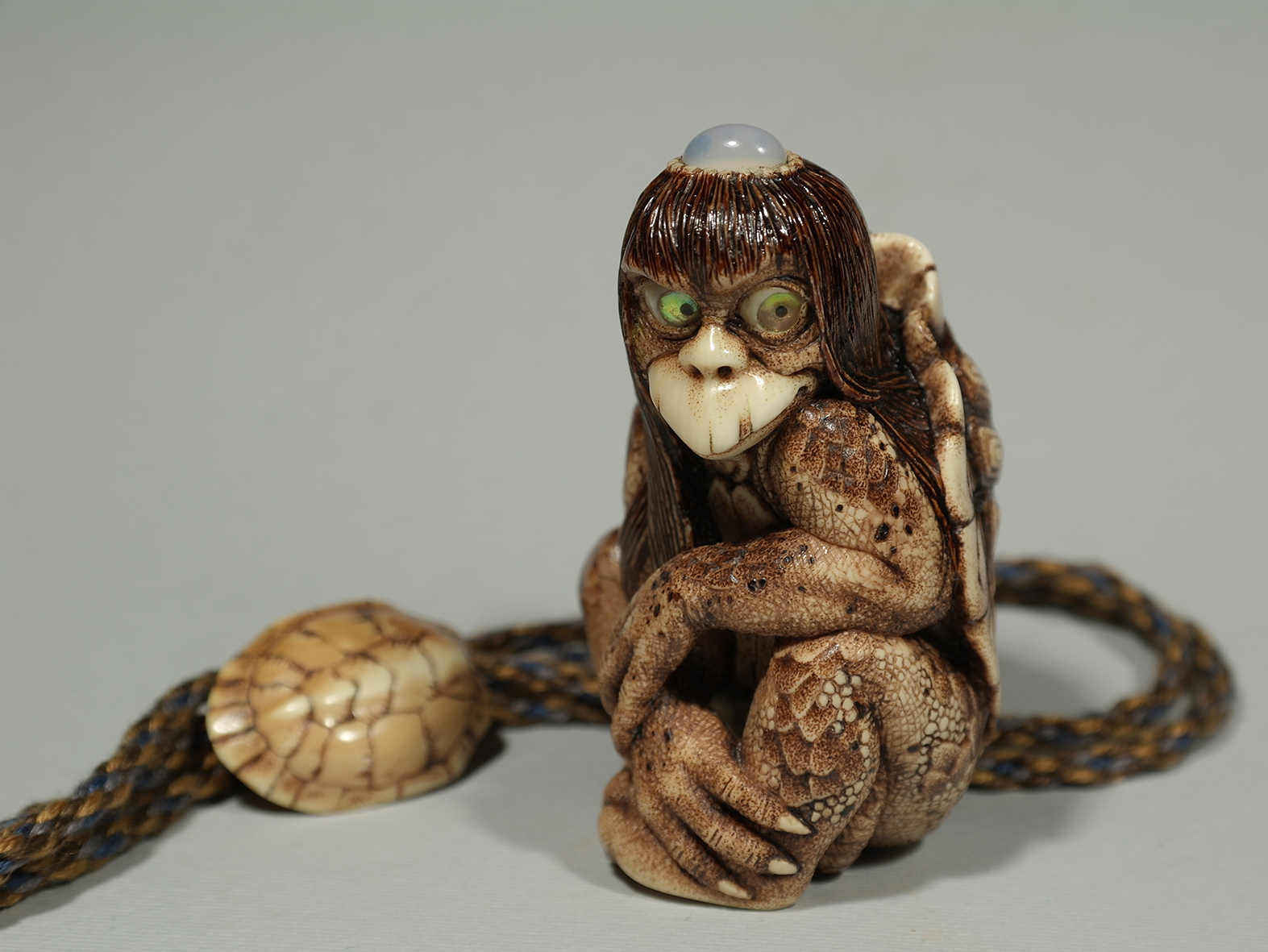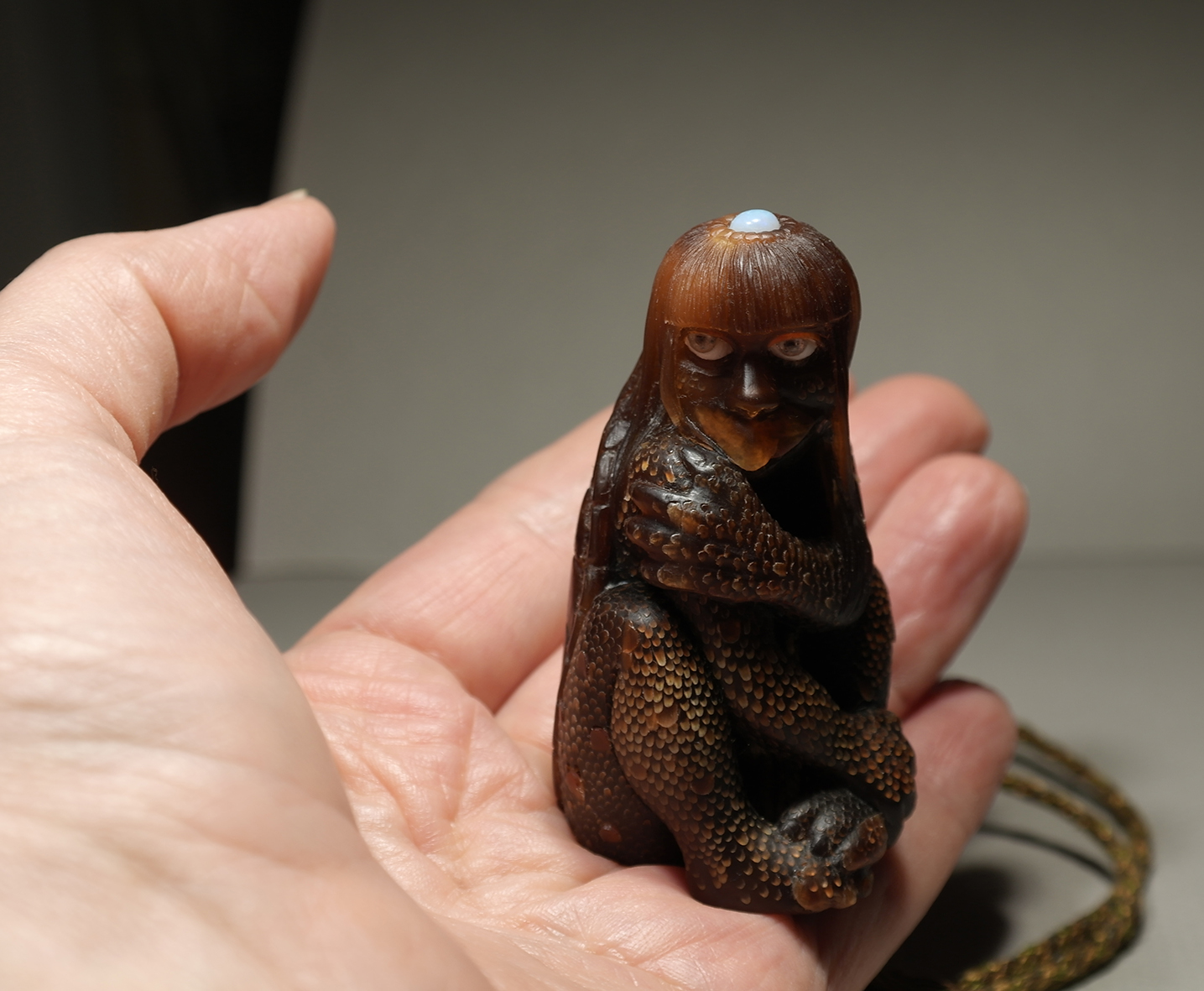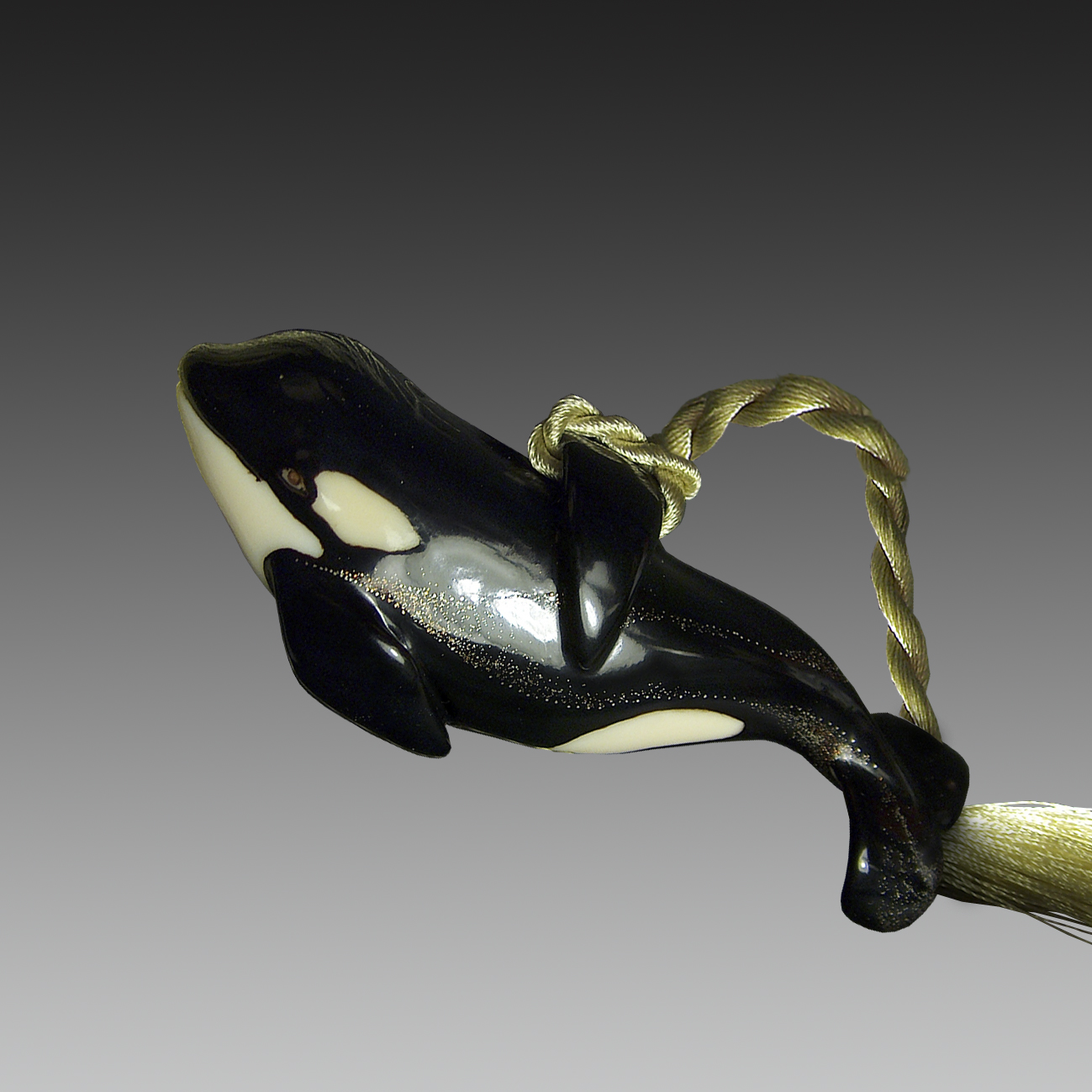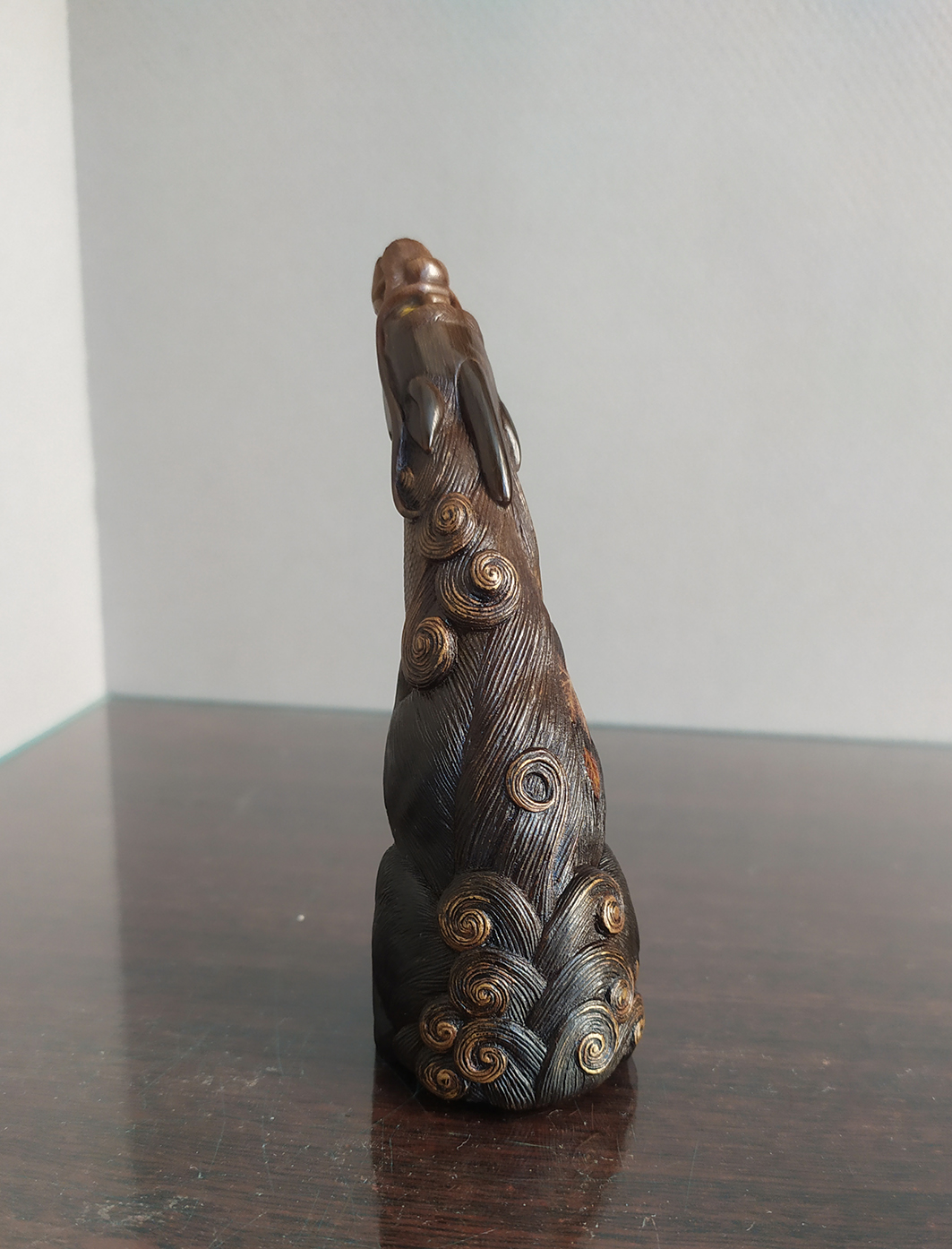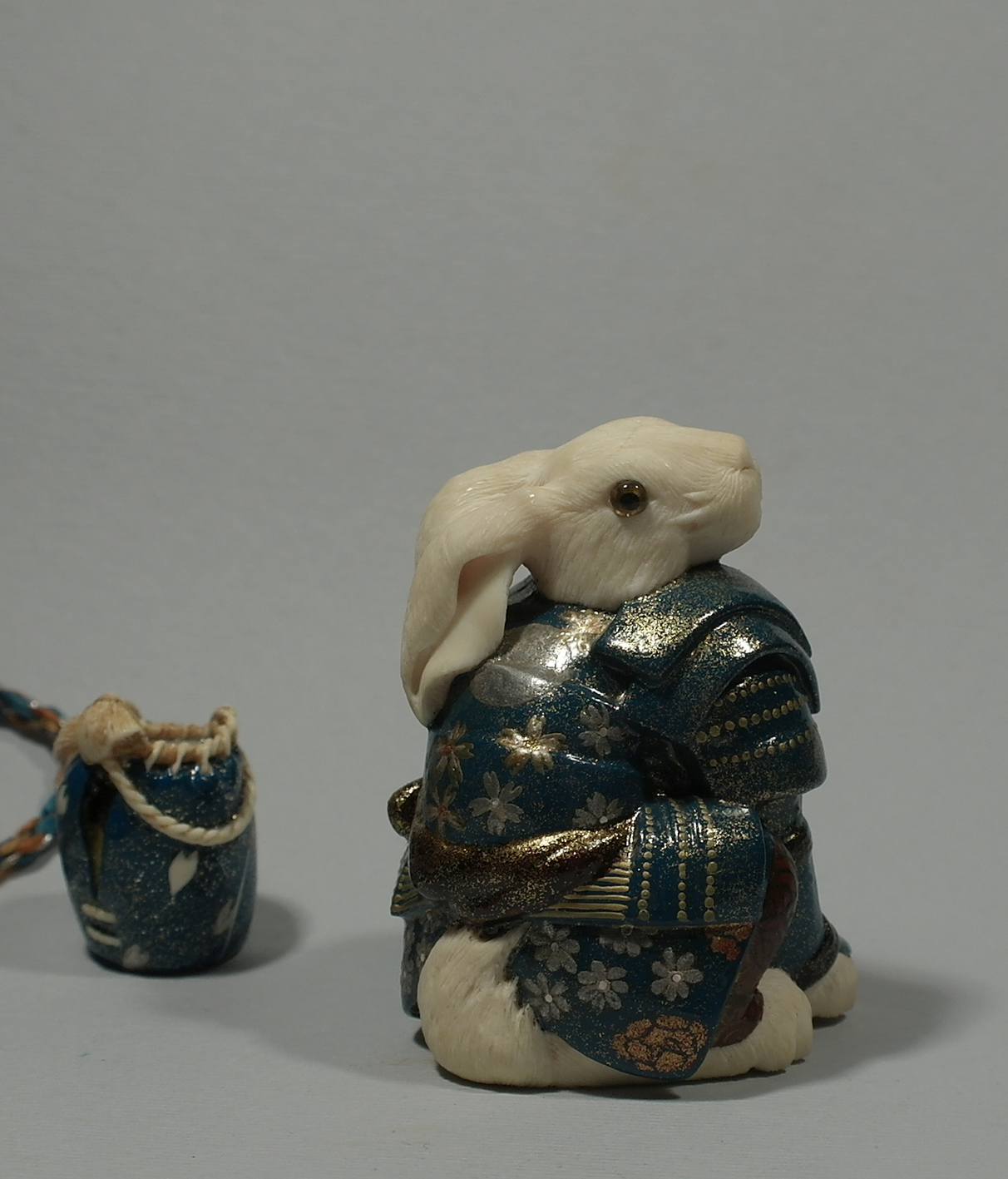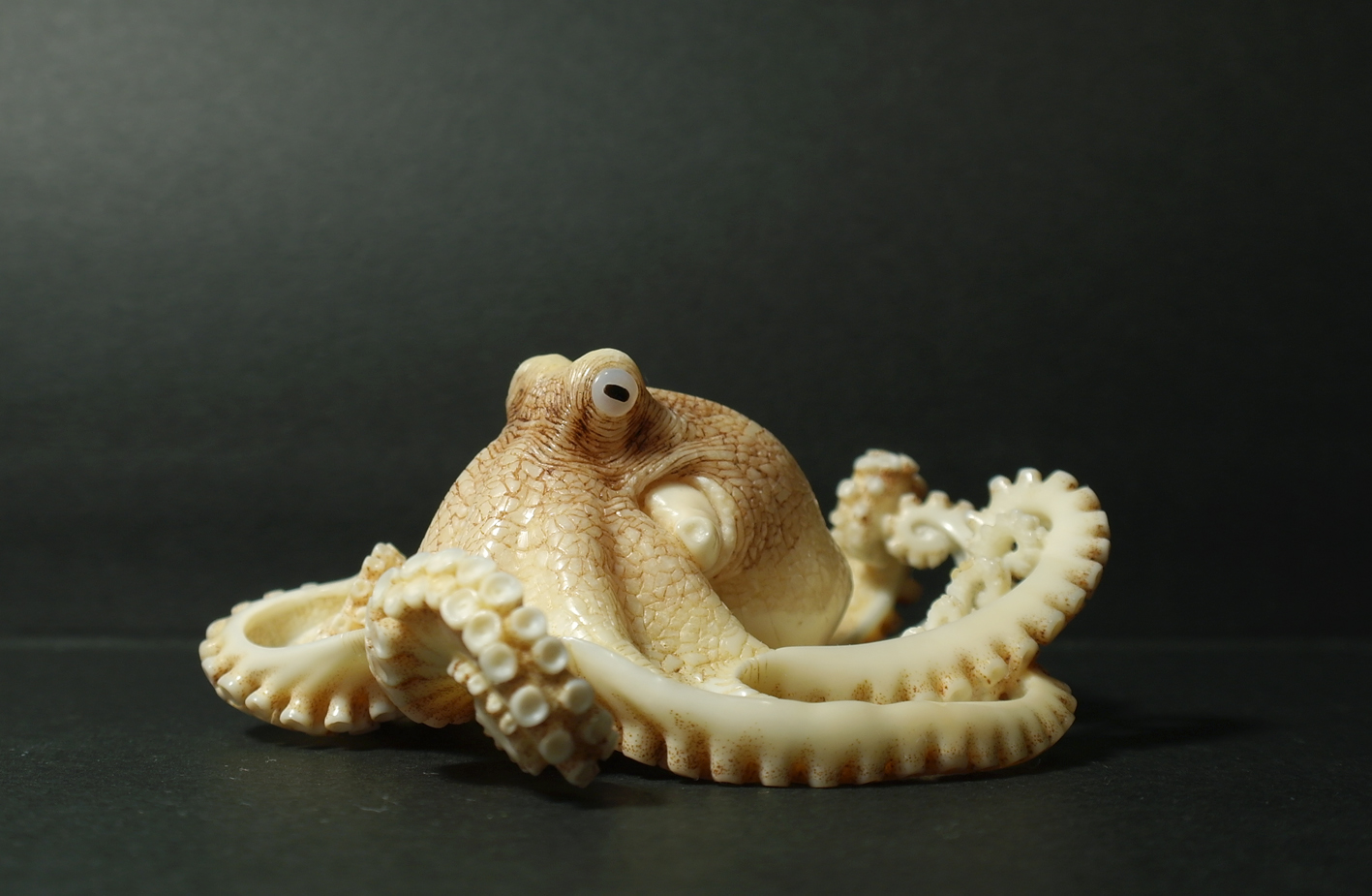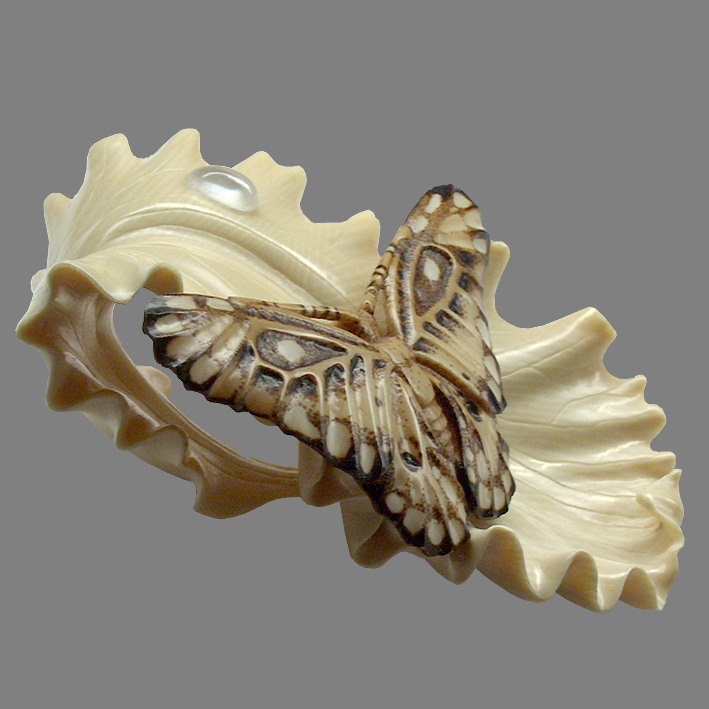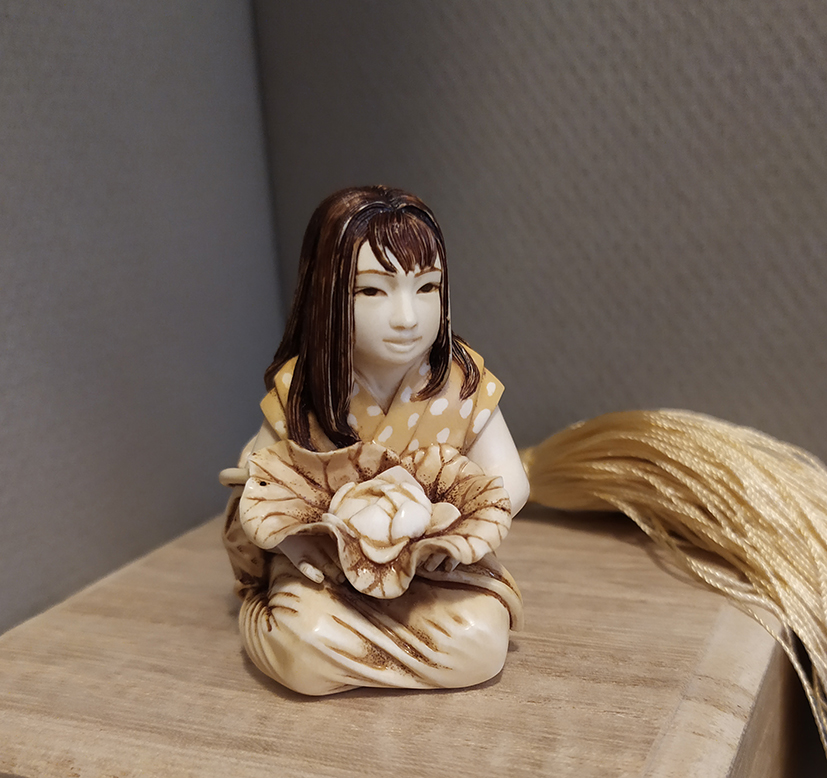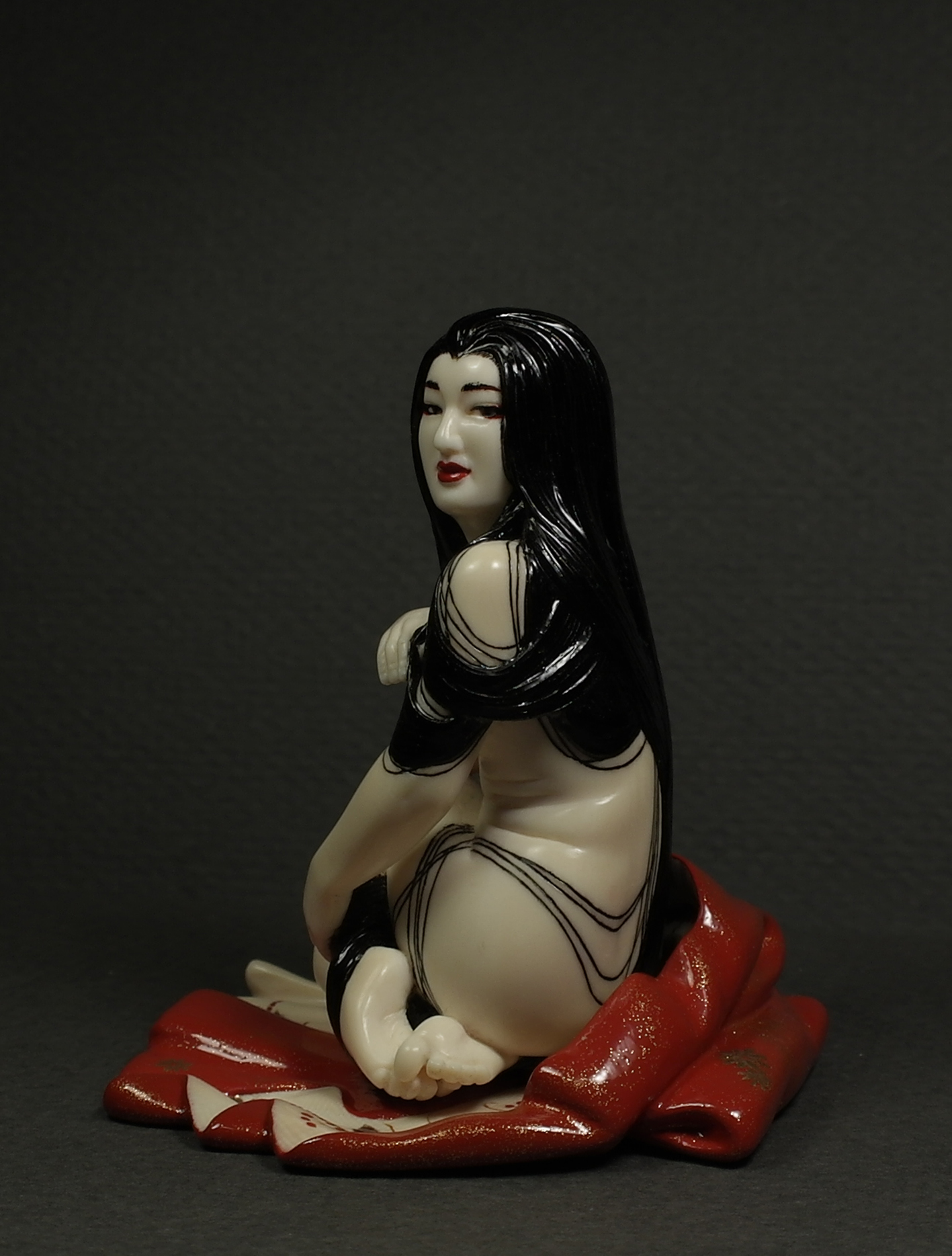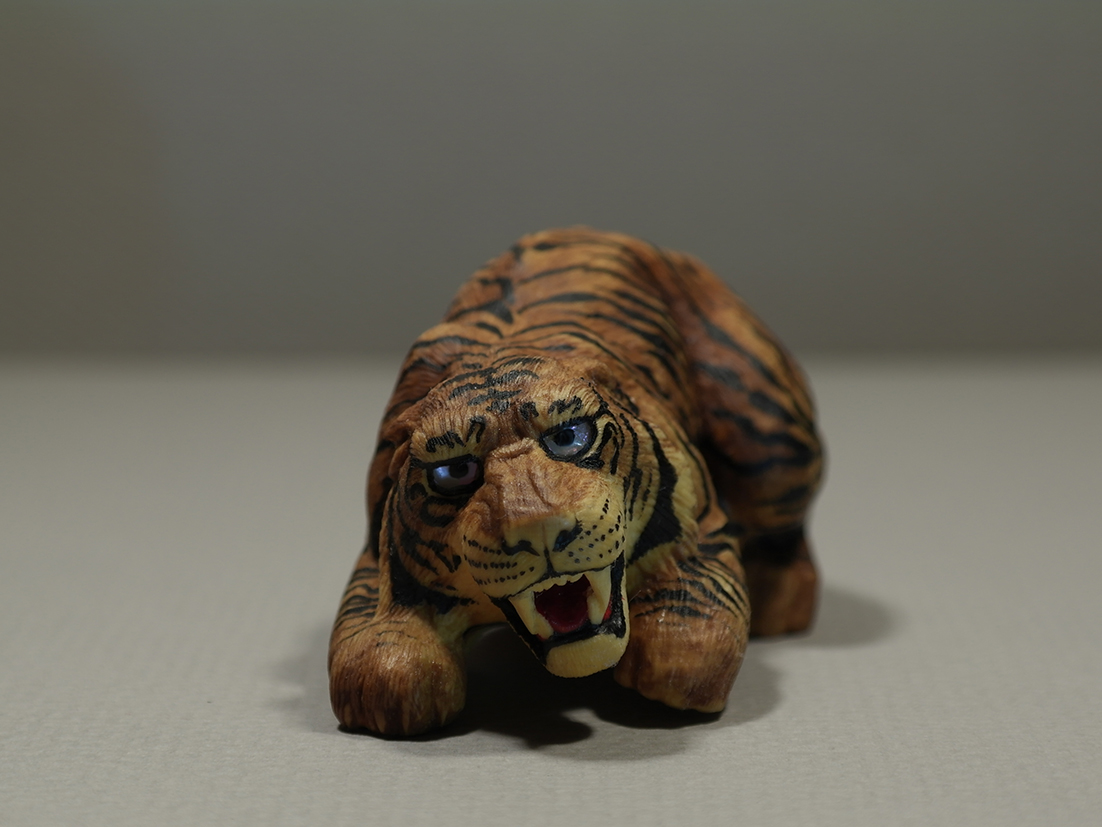KATABORI NETSUKE
BLOSSOMING CHERRY BRANCH
11 images
This Branch was carved from the African wild boar tusk, 12 cm, stained with Walnut ink, the Japanese characters were done with burning needle! :) The haiku can be translated so: Samazama no... Myriads of things past Koto omoidasu... Are brought to my mind - Sakura kana... These cherry blossoms! or so: How many, many things They bring to mind-- Cherry blossoms! Tatiana Nikolova and her friend, Tomoko Watanabe (the teacher of Japanese language and Literature) helped me a lot with the final design and searching this Haiku, with Japanese language and the grammar rules! I thank them both very much! UK, private collection.
![BLOSSOMING CHERRY BRANCH]()
CARP AMONG LOTUS LEAVES
10 images
Netsuke “Carp among lotus leaves” has been carved from pressed buffalo horn, its length is 6.8 cm, bleached, scaled, lotus leaves were lacquered with Nashiji Urushi (Togidashi with gold and silver hiramefun), 2010. Russia, private collection.
![CARP AMONG LOTUS LEAVES]()
FIGHTING BANTAMS
9 images
I was inspired very much with the design by Hokusai, this Katabori netsuke “Two Fighting Bantams” was carved from ivory, stained with Yashabushi, amber/gold inlaid eyes. Its height is 4.5 cm. Russia, private collection.
![FIGHTING BANTAMS]()
HARU-KO
6 images
Haru-ko was carved from walrus tusk. The size is 4.8 cm. The hair and make-up were done with Rose-Urushi lacquer. The ornament on the kimono and the basket were done with burning needle and walnut ink. Three petals were carved from pink coral. 2008. Australia, private collection.
![HARU-KO]()
KAPPA
18 images
Kappa (Japanese: 河童: "river child") is a Japanese species of mermen. Kappa is a child drowned by an oversight of adults, a child doomed to stay in the dusk of lakes, without love, care, a child offended by everyone and everything, therefore in Japanese mythology all Kappa are very evil and harmful creatures, if Kappa is given the opportunity drag someone to the bottom, it will be so. Kappa has a recess on his head with liquid, if Kappa bends down, the life-giving water will pour out and Kappa will lose his strength - this is the only way to defeat Kappa - bow to him, then Kappa will bow back, Kappa is very polite. I had already cut out the plot with Kappa on my Ryusa netsuke , and this time I wanted to create a Kappa with a ghost on the shell - an interesting idea in my opinion, I have never seen this idea anywhere. Kappa tries to see what is on his shell, and the ghost in horror has grown into the shell, now they are friends forever! The Kappa is carved from a piece of fossil mammoth tusk, tinted by Yashabushi and inked from walnuts, burned with a needle and Japanese lacquer - Urushi. Triple inlay Kappa eyes (mother of pearl, black buffalo horn and amber) and double inlay ghost eye (mother of pearl and black buffalo horn). Kappa height 6.3 cm. Ojimi is made in the form of an empty turtle shell, the cord is hand-woven. 2023. Russia, a private collection.
![KAPPA]()
KAPPA MUSUME
15 images
Usually Kappa are males with a turtle shell and a saucer of water on their heads, the main thing is not to spill it, otherwise the magic will be lost! Kappa are big fans of cucumbers, evil, impudent, they love to measure their strength in Sumo wrestling or just scare a gaping passerby. I already had a couple of netsuke on the Kappa theme. But not all Kappa are evil boys, this time meet a beautiful lady, Onna Kappa 女河童! And no cucumbers! ;) In general, the fashionable turtle shell and the signature saucer of water remind us that this beauty is from the Kappa family. Among the Kappa ladies, one character stands out - Kappa Musume 河童娘. Charming! Kappa turns into a sweet girl for one purpose, to eat something tasty. No treachery, purely gastronomic plans! Feed her once and she will become your constant and very grateful guest, sometimes she will cure you, sometimes she will bring you fish. But if you suspect her of being a Kappa and give her some bottle gourd juice, this lady will disappear into the river depths forever with the thought: "Here we go again!" Such is the drama about betrayal of trust and dislike of pumpkin. Do you like pumpkin? Here is a netsuke depicting Kappa Musume, the very girl from the Japanese legend who is about to turn into a girl and ask for something tasty. Just don't offer her a pumpkin, otherwise you will have to look for it in the nearest river! :) Her look will definitely not leave you indifferent, a little cunning and a drop of river magic. The horn of the African buffalo Zebu after bleaching acquires the beauty of amber, as if the sun is setting and its reflection paints the waves of the river in amber tones. The scales are applied using a special technique. Netsuke height 6.9 cm. Eyes inlaid: mammoth tusk, mother-of-pearl, black horn, amber. Ojime: two carps from the same horn, bleaching and with the same technique of applying scales. Twisted cord. 2025. Available for purchase.
![KAPPA MUSUME]()
KILLER-WHALE
5 images
This Killer Whale was carved from ivory, covered with black Roiro-Urushi lacquer, silver Hiramefu flakes, Nashiji-Urushi lacquer, amber inlaid eyes, 7 cm length, 2009. Moldova, a private collection.
![KILLER-WHALE]()
KIRIN
12 images
Kirin was carved from a black cow's horn, a fibrous material is difficult to carve in detail. I bleached it in places with hydrogen peroxide, it turned out a very beautiful transition from black to lighter Kirin's face. The whole body of Kirin is covered with hair and scales. The size of every tiny scale is 1 mm. After polishing, the Kirin was covered with Japanese lacquer Kijomi, gold powder Marufun on the curls, ribs protruding slightly on the sides. On its right side, autumn fallen leaves are made using the Maki-e technique using Kanshitsu. The eyes are inlaid three times, mother of pearl, black pupil horn and amber. 11 cm tall. 2020. USA, private collection.
![KIRIN]()
MONKEY
11 images
"Monkey and Reishi" was carved from elk antler, 5.3 cm tall. Amber inlaid eyes, Urushi lacquer, silver Hiramefun, Yashabushi (gardenia seeds), 2015. Switzerland, private collection.
![MONKEY]()
MOON RABBIT
17 images
If You look at the full Moon - Chushu no meigetsu, You can see the silhouette of a rabbit pounding in a mortar either the powder of immortality, or rice - the source of life, but the rabbit turned out to be on the Moon for his self-sacrifice for the Buddha. The rabbit is also known for its good disposition, intelligence and ingenuity, quick legs, and also courage, which is probably why the Silver Gate on the Moon is also guarded by rabbits. My version of the gatekeeper is a white rabbit in armor like a samurai. In other words, this is a story about a Japanese rabbit guarding a bag with a pot, in which either the powder of immortality, or rice. This rabbit is made from a piece of mammoth tusk, the armor is covered with Urushi lacquers, gold and silver powder, the eyes are inlaid, the height of the rabbit is 5.1 cm, ojime is 2.5 cm, hand-woven cord. 2023. Belgium, the private collection.
![MOON RABBIT]()
OCTOPUS
19 images
Octopus has been carved from walrus tusk, its diameter is 7.4 cm. 2016. Switzerland, private collection.
![OCTOPUS]()
OCTOPUS II
22 images
In Japan, the octopus itself symbolizes the center of the universe and the beginning of all creation. It is also associated with the depths of the human soul, its subconscious and inner world, and is a powerful and enduring symbol of change and transformation. Octopuses are known for their problem-solving skills and adaptability, making them a symbol of intelligence and survival, and there are a number of myths and legends associated with the octopus, which have also surrounded its image with a powerful erotic component. Irezumi (from Japanese 入れ墨 - "ink injection") is a Japanese tattoo, the image of an octopus often symbolizes internal change or the desire to change, and is applied by people who want to radically change their lifestyle. Octopuses are unique animals - they are able to solve problems, use tools and demonstrate complex behaviors such as play. This is my second octopus - a mysterious creature of the abyss. The beautiful translucent mantle only adds mystery to this animal, so much unusual is concentrated in one octopus. The second octopus is carved from a piece of mammoth tusk. I especially like this material, it is hard enough for carving small details and at the same time slightly translucent in a thin layer, this gives realism to this netsuke. To add color, I used Yashabushi vegetable dye, and worked out the details using pyrography (burning with a needle). I inlaid the octopus's eyes with mother-of-pearl, which added liveliness and expressiveness to this netsuke. 6.7 x 6.2 x 3 cm. December, 2024. The private collection, USA.
![OCTOPUS II]()
PETAL BUTTERFLY
3 images
The petal of Iris with butterfly were carved from mammoth tusk, its size is 5.6 cm, the butterfly was stained with walnut dye, silver nitrate and burning needle. Two dew-drops were carved from two different acryl glass. The beetle was carved from mammoth and dark-brow shell, mammoth was covered silver nitrate. The signature was carved on the reverse side, covered gold leaf 23K and over it was inlaid the dew-drop. January 2007. USA, private collection
![PETAL BUTTERFLY]()
SANKA WITH BAMBOO
9 images
Sanka with bamboo has been carved from mammoth tuisk, 4.8 cm tall, Urushi lacquer, Yashabushi dye, burning needle. 2013. Australia, private collection. The people of the mountains – unidentified inhabitants or nomads who lived by fishing and hunting. They're called Sanka and have never been identified as a different race. Until the family register system was set up after the Meiji Restoration [1868], the Sanka or Sanga were a free people who existed outside the government’s control. They were distributed throughout the whole country from the southern Kyushu region to the northern Tohoku. It is believed that they were pushed north by the peoples who arrived relatively later in history. Refusing to be assimilated, they escaped to the mountains. It is also believed that “they could be part of the Jomon people, J apanese ancestors with a Polynesian linkage.” In other words, their existence can only be explained if we consider them as the part of aboriginal races that resisted assimilation. Sanka had contacts with the new populations so they weren't completely apart from civilization.
SANKA WITH LOTUS LEAVES
9 images
Sanka with lotus leaves has been carved from mammoth tuisk, 4.7 cm tall, Urushi lacquer, Yashabushi dye, burning needle. 2014. Australia, private collection. The people of the mountains – unidentified inhabitants or nomads who lived by fishing and hunting. They're called Sanka and have never been identified as a different race. Until the family register system was set up after the Meiji Restoration [1868], the Sanka or Sanga were a free people who existed outside the government’s control. They were distributed throughout the whole country from the southern Kyushu region to the northern Tohoku. It is believed that they were pushed north by the peoples who arrived relatively later in history. Refusing to be assimilated, they escaped to the mountains. It is also believed that “they could be part of the Jomon people, J apanese ancestors with a Polynesian linkage.” In other words, their existence can only be explained if we consider them as the part of aboriginal races that resisted assimilation. Sanka had contacts with the new populations so they weren't completely apart from civilization.
![SANKA WITH LOTUS LEAVES]()
SNAKE AND FROG
16 images
SNAKE AND FROG Snake and Frog It would seem nothing unusual, but in the Japanese tradition, this couple often appears as part of a cool symbolic triad called Sansukumi (三竦み) - just like rock-paper-scissors, only in Japanese! This multi-layered "kimono" with a deep meaning and its own unique dynamics, the eternal dance of good and evil, opposing forces, where the weakling can unexpectedly fight back. Netsuke, these tiny masterpieces, have become an ideal stage for this motif. Imagine: a whole drama unfolds in such a miniature space! Many netsuke masters took on this "snake-frog" theme with pleasure. It turns out that a snake is not only a dangerous reptile, but also a symbol of wisdom, protection and fertility. And a frog is generally a talisman of luck, wealth and a safe return home. This motif can be understood in different ways: as a banal struggle for survival (who will eat whom), and as the eternal cycle of life and death, and as an allegory of the confrontation between the weak and the strong, and even as a reminder of the inevitability of fate. There may also be hidden irony or even a moral here: like, be careful and don’t mess with those who are bigger than you. It was my first time using black coral for my netsuke, it is a very beautiful raw material, its deep, almost mystical shade (in fact, the color of its internal skeleton varies from black to brown due to the unique elastic protein antipatin) combined with the shimmer of mother-of-pearl and the warm glow of amber in the inlay of the snake's eyes creates a truly mesmerizing effect, like the look of a wise and dangerous creature, and Japanese Urushi lacquers add color accents. I am very grateful to Nikita Strukov for this wonderful gift in the form of a couple of pieces of black coral! The scene with a frog hiding from a snake is a fairly common motif in netsuke, often symbolizing cunning, evasiveness, or even a game of fate, chance - will you be lucky or unlucky? Using amber for the frog and adding Urushi lacquers to bring it to life is a great idea, it makes the frog stand out against the black coral and the translucency of the amber conveys the frog's skin well. And the ojimi (a little thing on a cord) with a frog and two ants is almost a mini-performance! Ants, these little workers, usually symbolize hard work and perseverance. Maybe this whole company will remind someone of an old instructive story that happened a long time ago and will bring on a nostalgic mood. I remembered Basho's haiku: An old pond. A frog jumped into the water. A splash in the silence. I may have read something similar somewhere, but another haiku for "Snake and Frog" came to mind: Silence... The shadow of a snake flashed... There is no frog. The netsuke is 8.9 cm long, a fairly large piece, which allowed me to work out every detail, from the scales of the snake to the webbed feet of the frog. The inlay of the snake's eyes with mother-of-pearl, black horn and amber is not just a decoration, but a way to convey the depth and expressiveness of the look. This netsuke has a dual purpose, it can be used as a fudekake - a netsuke stand for three brushes or as a kiserukake stand for a smoking pipe. The 1.9cm long ojimi, made of fine ebony and decorated with a frog covered in yellow and black Urushi lacquer with the warm glow of gold Nashiji glitter, is another exquisite detail. 2025. Available for purchase.
![SNAKE AND FROG]()
SUMO
5 images
"Sumo Wrestlers" has been carved from a piece of mammoth tusk, the height of this netsuke is 9.1 cm, tinted with mixed dye (kuchinashi, curcuma and tea), hear - Rose Urushi, mawasi - colored with lacquers and Nashiji flakes (gold and silver), tattoo was done with hot needle. 2013. "Sumo Wrestlers" is a part of the LUB collection!
![SUMO]()
TAYU
25 images
Tayu is Empress Hanamachi, she has 5th rank, the highest degree of skill. In addition to sophisticated communication, the tea ceremony and other subtleties, the Taiu mastered the art of "spring quarters" until the ban on prostitution in Japan in 1956. Netsuke height is 7 cm, inlaid eyes with a black horn, Urushi varnishes: red and black Kuro-nakanuri, gold Nashiji flakes, gold Marufun. December 2021. Russia, private collection.
![TAYU]()
TIGER
17 images
In Japanese mythology and art, tigers are often depicted as powerful, fearless and noble creatures, capable of protecting against evil spirits and negative energy and overcoming any obstacles. The tiger is also one of the signs of the Chinese zodiac, which has been adopted in Japanese culture. People born in the year of the tiger are considered strong, independent and brave. Tigers are often depicted in Japanese painting. Artists try to convey the grace and power of this animal using various techniques and styles. Images of tigers often decorate traditional Japanese screens and scrolls. In samurai culture, tigers symbolize military valor and fortitude. Samurai often used images of tigers on their armor and banners to emphasize their strength and fearlessness. The Tiger was carved from boxwood, length 7 cm, width and height 3.7 cm, mother-of-pearl inlay for eyes, Yashabushi - tinted. January, 2025. Private collection, USA.
![TIGER]()
TIGRESS and a CUB
16 images
The netsuke "Tigress and a cub" is a typical theme for Japanese miniature sculptures. It depicts the maternal love and care of a tigress for her cub. The tigress protects and nurtures the cub, symbolizing the strong bond between a mother and her child. Such netsuke are often used as amulets to bring good luck and protect their owner. Tigress and a cub was carved from boxwood, stained with Yashabushi, black Urushi, mother-of-pearl inlaid eyes. Height - 3.7 cm, length - 6.7 cm, width 3.4 cm 2024
![TIGRESS and a CUB]()
